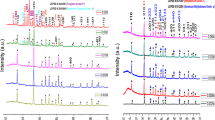Abstract
The objective of this investigation was to explain the variation in dielectric constants of mullite ceramics prepared with 25% excess silica under a variety of conditions as described in an earlier study. Different starting materials, mullite-silica (M-S) and alumina-silica (A-S), different particle sizes (fine or coarse) and different firing times and temperatures were used. Dielectric constants measured for the alumina-silica system at 1550°C at different times, showed an initial reduction followed by an increase on further heating. The dielectric constants of other systems increased with increase in heat-treatment time at the different heat-treatment temperatures. From the study of microstructures using transmission electron microscopy and energy dispersive X-ray spectroscopy, it was shown that the initial decrease in dielectric constant on heating the alumina-silica system was because alumina, a phase with a higher dielectric constant was being replaced by mullite, a phase with a lower dielectric constant. On completion of this reaction, the intergranular silica was absorbed by mullite thereby leading to an increase in the dielectric constant. It was then shown that whenever phases with a lower dielectric constant exist, the dielectric constant of the system as a whole is lower.
Similar content being viewed by others
References
B. Schwartz, in “Electronic Ceramics”, edited by L. M. Levinson (Marcel Dekker, New York, 1988) Ch. 1, pp. 1–44.
Y. Hamano andM. Terasawa, in “Electronic Packaging Materials Science II”, edited by K. A. Jackson, R. C. Pohanha, D. R. Uhlmann and D. R. Ulrich, Materials Research Society Symposia Proceedings 72(MRS, Palo Alto, CA, 1986) pp. 3–13.
D. P. Seraphim, R. Laski andC. Li, “Principles of Electronic Packaging” (McGraw-Hill, New York, 1989) pp. 282–332.
R. T. Tummala,J. Amer. Ceram. Soc. 74 (1991) 895.
E. A. Giess, J. M. Roldan, P. J. Bailey andE. Goo, in “Ceramic Transactions”, Vol. 15, edited by K. M. Nair, R. Pohanka and R. C. Buchanan (American Ceramic Society, Westerville, OH, 1990).
H. K. Bowen andJ. W. Greig,J. Amer. Ceram. Soc. 7 (1924) 238; corrections,ibid. 7 (1924) 410.
S. Aramki andR. Roy,ibid. 45 (1962) 229.
S. H. Risbud andJ. A. Pask,ibid. 60 (1972) 418.
I. A. Aksay andJ. A. Pask,ibid. 58 (1975) 507.
W. M. Kriven andJ. A. Pask,ibid. 66 (1983) 649.
F. J. Klug andS. Prochazka,ibid. 70 (1988) 750.
A. J. Skoog andR. E. Moore,Bull. Amer. Ceram. Soc. 67 (1988) 1180.
Author information
Authors and Affiliations
Rights and permissions
About this article
Cite this article
Ramakrishnan, V., Goo, E., Roldan, J.M. et al. Microstructure of mullite ceramics used for substrate and packaging applications. J Mater Sci 27, 6127–6130 (1992). https://doi.org/10.1007/BF01133760
Received:
Accepted:
Issue Date:
DOI: https://doi.org/10.1007/BF01133760




